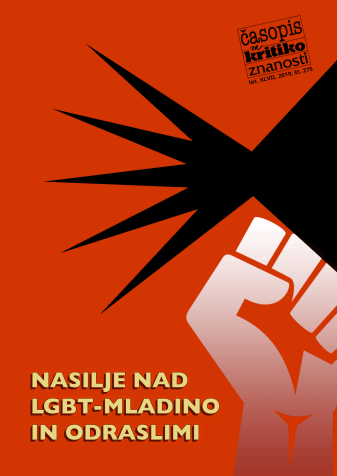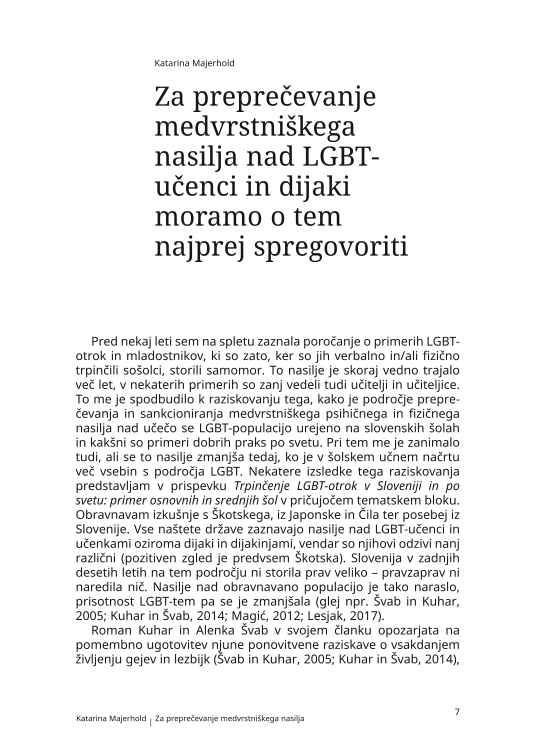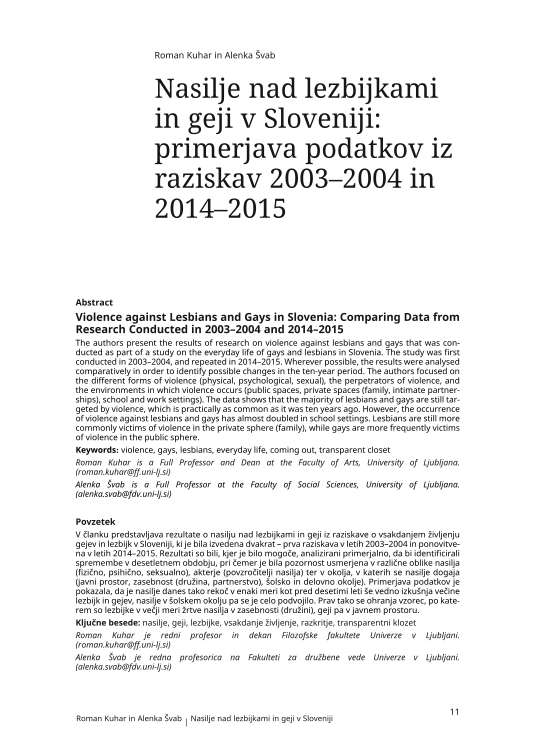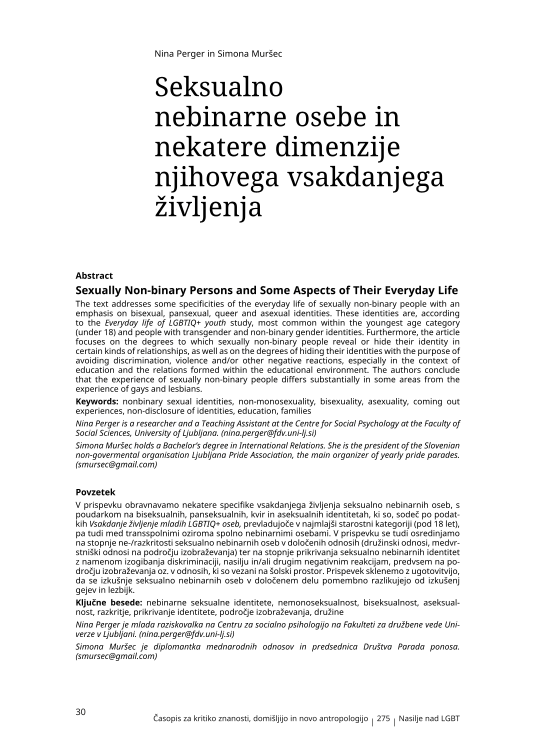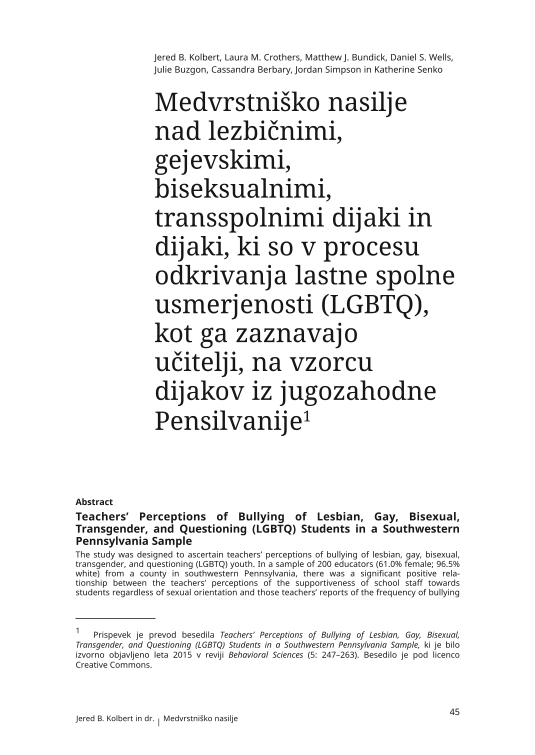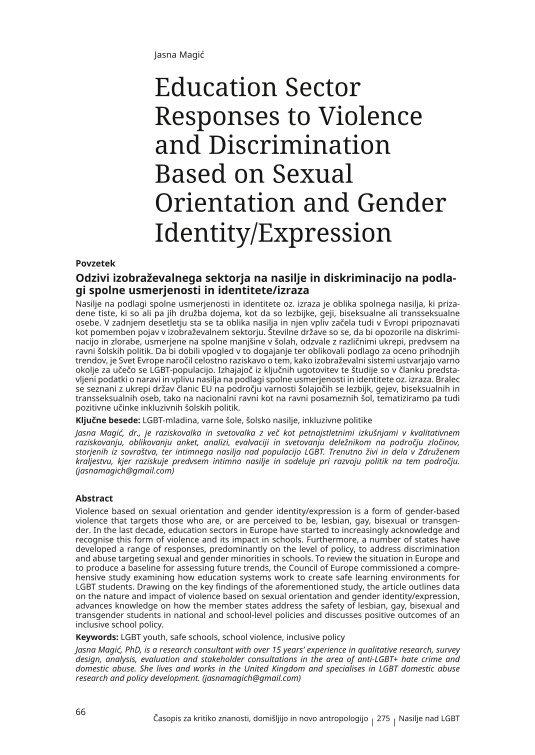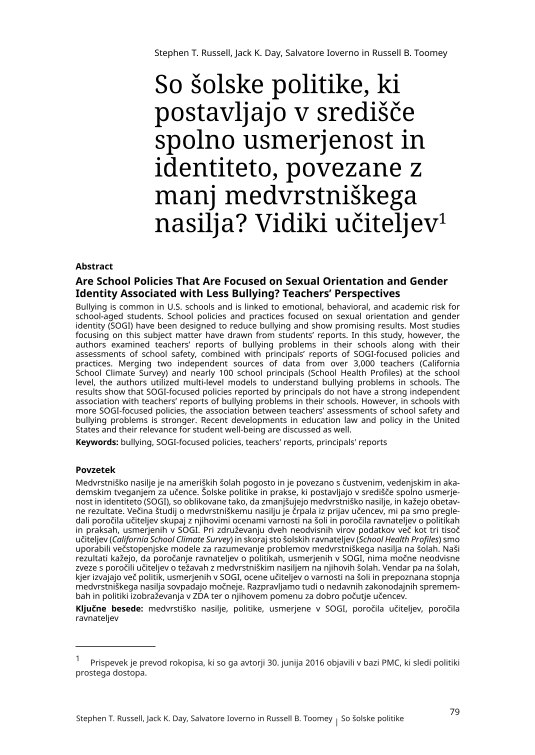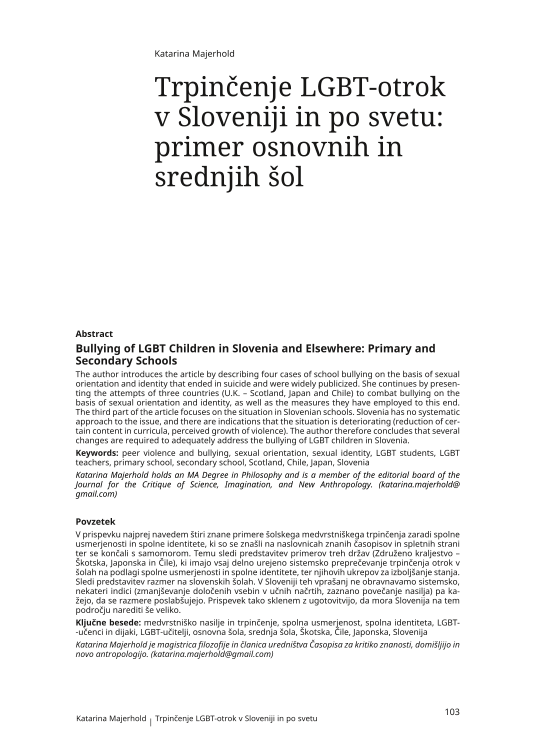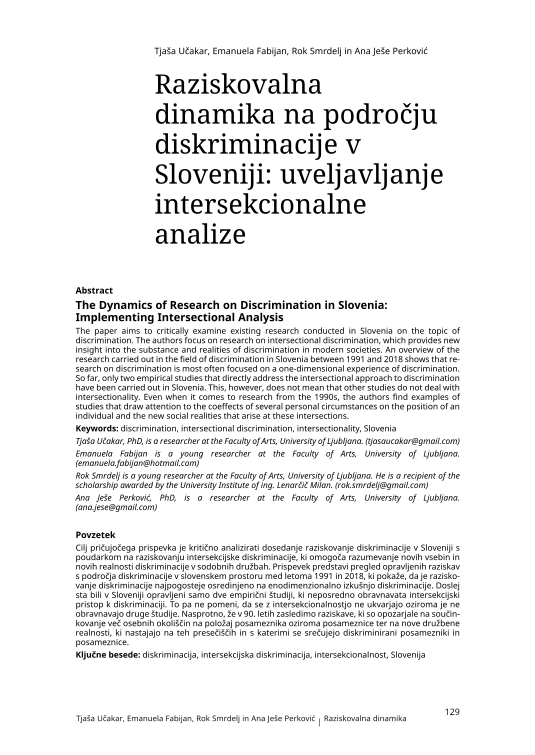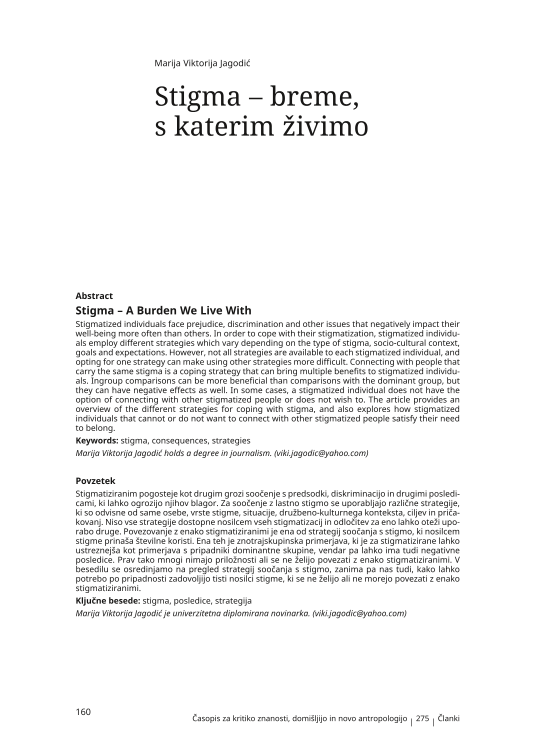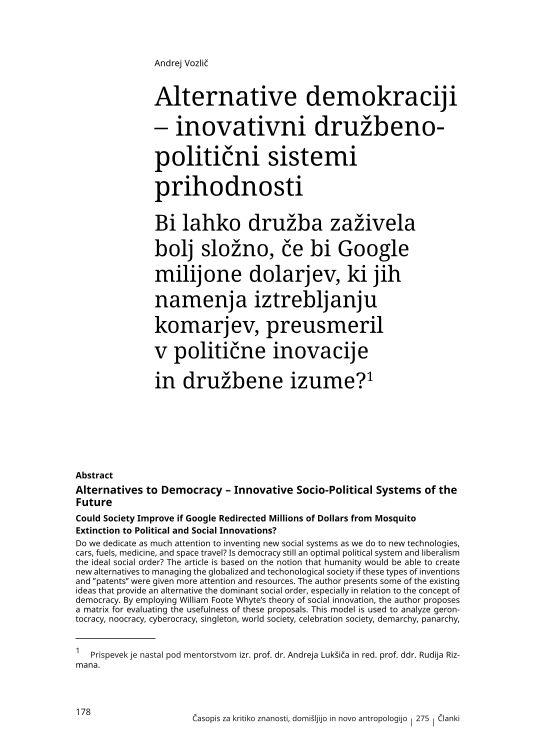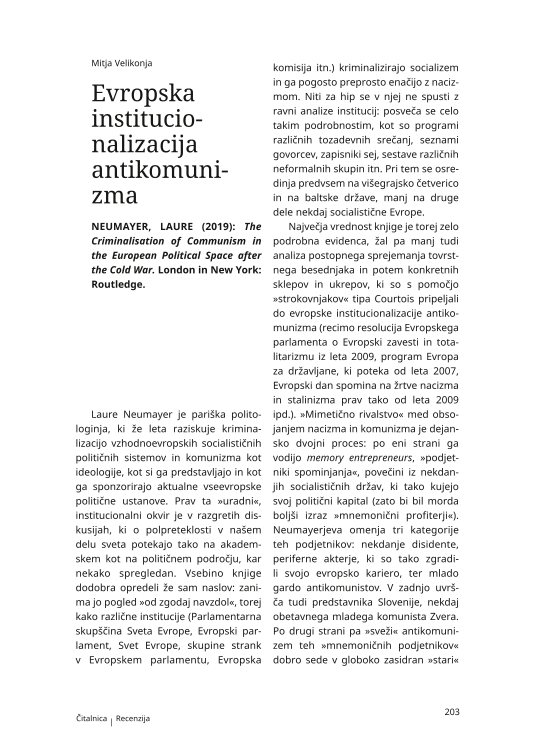Pred nekaj leti sem na spletu zaznala poročanje o primerih LGBT-otrok in mladostnikov, ki so zato, ker so jih verbalno in/ali fizično trpinčili sošolci, storili samomor. To nasilje je skoraj vedno trajalo več let, v nekaterih primerih so zanj vedeli tudi učitelji in učiteljice. To me je spodbudilo k raziskovanju tega, kako je področje preprečevanja in sankcioniranja medvrstniškega psihičnega in fizičnega nasilja nad učečo se LGBT-populacijo urejeno na slovenskih šolah in kakšni so primeri dobrih praks po svetu. Pri tem me je zanimalo tudi, ali se to nasilje zmanjša tedaj, ko je v šolskem učnem načrtu več vsebin s področja LGBT. Nekatere izsledke tega raziskovanja predstavljam v prispevku Trpinčenje LGBT-otrok v Sloveniji in po svetu: primer osnovnih in srednjih šol v pričujočem tematskem bloku. Obravnavam izkušnje s Škotskega, iz Japonske in Čila ter posebej iz Slovenije. Vse naštete države zaznavajo nasilje nad LGBT-učenci in učenkami oziroma dijaki in dijakinjami, vendar so njihovi odzivi nanj različni (pozitiven zgled je predvsem Škotska). Slovenija v zadnjih desetih letih na tem področju ni storila prav veliko – pravzaprav ni naredila nič. Nasilje nad obravnavano populacijo je tako naraslo, prisotnost LGBT-tem pa se je zmanjšala (glej npr. Švab in Kuhar, 2005; Kuhar in Švab, 2014; Magić, 2012; Lesjak, 2017).
The authors present the results of research on violence against lesbians and gays that was conducted as part of a study on the everyday life of gays and lesbians in Slovenia. The study was first conducted in 2003–2004, and repeated in 2014–2015. Wherever possible, the results were analysed comparatively in order to identify possible changes in the ten-year period. The authors focused on the different forms of violence (physical, psychological, sexual), the perpetrators of violence, and the environments in which violence occurs (public spaces, private spaces (family, intimate partnerships), school and work settings). The data shows that the majority of lesbians and gays are still targeted by violence, which is practically as common as it was ten years ago. However, the occurrence of violence against lesbians and gays has almost doubled in school settings. Lesbians are still more commonly victims of violence in the private sphere (family), while gays are more frequently victims of violence in the public sphere.
The text addresses some specificities of the everyday life of sexually non-binary people with an emphasis on bisexual, pansexual, queer and asexual identities. These identities are, according to the Everyday life of LGBTIQ+ youth study, most common within the youngest age category (under 18) and people with transgender and non-binary gender identities. Furthermore, the article focuses on the degrees to which sexually non-binary people reveal or hide their identity in certain kinds of relationships, as well as on the degrees of hiding their identities with the purpose of avoiding discrimination, violence and/or other negative reactions, especially in the context of education and the relations formed within the educational environment. The authors conclude that the experience of sexually non-binary people differs substantially in some areas from the experience of gays and lesbians.
The study was designed to ascertain teachers’ perceptions of bullying of lesbian, gay, bisexual, transgender, and questioning (LGBTQ) youth. In a sample of 200 educators (61.0% female; 96.5% white) from a county in southwestern Pennsylvania, there was a significant positive relationship between the teachers’ perceptions of the supportiveness of school staff towards students regardless of sexual orientation and those teachers’ reports of the frequency of bullying victimization experienced by LGBTQ students. Teachers’ perceptions of a higher level of staff and student support was associated with higher reported frequencies of students’ use of derogatory language about LGBTQ individuals and various types of bullying of LGBTQ students. Teachers with a lesbian, gay, or bisexual orientation were found to rate the school staff and students as significantly less supportive of students regardless of their sexual orientation, gender identity, or gender expression in comparison to heterosexual teachers. Finally, teachers who were either unaware of their school having an anti-bullying policy or believed that their school lacked such a policy reported significantly higher rates of physical bullying of LGBTQ students when compared to the rates observed by teachers who reported knowledge of their schools’ anti-bullying policies.
Violence based on sexual orientation and gender identity/expression is a form of gender-based violence that targets those who are, or are perceived to be, lesbian, gay, bisexual or transgender. In the last decade, education sectors in Europe have started to increasingly acknowledge and recognise this form of violence and its impact in schools. Furthermore, a number of states have developed a range of responses, predominantly on the level of policy, to address discrimination and abuse targeting sexual and gender minorities in schools. To review the situation in Europe and to produce a baseline for assessing future trends, the Council of Europe commissioned a comprehensive study examining how education systems work to create safe learning environments for LGBT students. Drawing on the key findings of the aforementioned study, the article outlines data on the nature and impact of violence based on sexual orientation and gender identity/expression, advances knowledge on how the member states address the safety of lesbian, gay, bisexual and transgender students in national and school-level policies and discusses positive outcomes of an inclusive school policy.
Bullying is common in U.S. schools and is linked to emotional, behavioral, and academic risk for school-aged students. School policies and practices focused on sexual orientation and gender identity (SOGI) have been designed to reduce bullying and show promising results. Most studies focusing on this subject matter have drawn from students’ reports. In this study, however, the authors examined teachers’ reports of bullying problems in their schools along with their assessments of school safety, combined with principals’ reports of SOGI-focused policies and practices. Merging two independent sources of data from over 3,000 teachers (California School Climate Survey) and nearly 100 school principals (School Health Profiles) at the school level, the authors utilized multi-level models to understand bullying problems in schools. The results show that SOGI-focused policies reported by principals do not have a strong independent association with teachers’ reports of bullying problems in their schools. However, in schools with more SOGI-focused policies, the association between teachers’ assessments of school safety and bullying problems is stronger. Recent developments in education law and policy in the United States and their relevance for student well-being are discussed as well.
The author introduces the article by describing four cases of school bullying on the basis of sexual orientation and identity that ended in suicide and were widely publicized. She continues by presenting the attempts of three countries (U.K. – Scotland, Japan and Chile) to combat bullying on the basis of sexual orientation and identity, as well as the measures they have employed to this end. The third part of the article focuses on the situation in Slovenian schools. Slovenia has no systematic approach to the issue, and there are indications that the situation is deteriorating (reduction of certain content in curricula, perceived growth of violence). The author therefore concludes that several changes are required to adequately address the bullying of LGBT children in Slovenia.
The Dynamics of Research on Discrimination in Slovenia: Implementing Intersectional Analysis
(
The paper aims to critically examine existing research conducted in Slovenia on the topic of discrimination. The authors focus on research on intersectional discrimination, which provides new insight into the substance and realities of discrimination in modern societies. An overview of the research carried out in the field of discrimination in Slovenia between 1991 and 2018 shows that research on discrimination is most often focused on a one-dimensional experience of discrimination. So far, only two empirical studies that directly address the intersectional approach to discrimination have been carried out in Slovenia. This, however, does not mean that other studies do not deal with intersectionality. Even when it comes to research from the 1990s, the authors find examples of studies that draw attention to the coeffects of several personal circumstances on the position of an individual and the new social realities that arise at these intersections.
Stigmatized individuals face prejudice, discrimination and other issues that negatively impact their well-being more often than others. In order to cope with their stigmatization, stigmatized individuals employ different strategies which vary depending on the type of stigma, socio-cultural context, goals and expectations. However, not all strategies are available to each stigmatized individual, and opting for one strategy can make using other strategies more difficult. Connecting with people that carry the same stigma is a coping strategy that can bring multiple benefits to stigmatized individuals. Ingroup comparisons can be more beneficial than comparisons with the dominant group, but they can have negative effects as well. In some cases, a stigmatized individual does not have the option of connecting with other stigmatized people or does not wish to. The article provides an overview of the different strategies for coping with stigma, and also explores how stigmatized individuals that cannot or do not want to connect with other stigmatized people satisfy their need to belong.
Do we dedicate as much attention to inventing new social systems as we do to new technologies, cars, fuels, medicine, and space travel? Is democracy still an optimal political system and liberalism the ideal social order? The article is based on the notion that humanity would be able to create new alternatives to managing the globalized and techonological society if these types of inventions and ’’patents’’ were given more attention and resources. The author presents some of the existing ideas that provide an alternative the dominant social order, especially in relation to the concept of democracy. By employing William Foote Whyte’s theory of social innovation, the author proposes a matrix for evaluating the usefulness of these proposals. This model is used to analyze gerontocracy, noocracy, cyberocracy, singleton, world society, celebration society, demarchy, panarchy, futarchy, and delegative democracy. The author finds that there is a serious lack of viable and useful socio-political alternatives, but there is an even bigger issue: in contrast to the natural sciences, social scientists do not have a laboratory for testing alternative models in an efficient and harmless manner.
NEUMAYER, LAURE (2019): The Criminalisation of Communism in the European Political Space after the Cold War. London in New York: Routledge.
Laure Neumayer je pariška politologinja, ki že leta raziskuje kriminalizacijo vzhodnoevropskih socialističnih političnih sistemov in komunizma kot ideologije, kot si ga predstavljajo in kot ga sponzorirajo aktualne vseevropske politične ustanove. Prav ta »uradni«, institucionalni okvir je v razgretih diskusijah, ki o polpreteklosti v našem delu sveta potekajo tako na akademskem kot na političnem področju, kar nekako spregledan. Vsebino knjige dodobra opredeli že sam naslov: zanima jo pogled »od zgodaj navzdol«, torej kako različne institucije (Parlamentarna skupščina Sveta Evrope, Evropski parlament, Svet Evrope, skupine strank v Evropskem parlamentu, Evropska komisija itn.) kriminalizirajo socializem in ga pogosto preprosto enačijo z nacizmom. Niti za hip se v njej ne spusti z ravni analize institucij: posveča se celo takim podrobnostim, kot so programi različnih tozadevnih srečanj, seznami govorcev, zapisniki sej, sestave različnih neformalnih skupin itn. Pri tem se osredinja predvsem na višegrajsko četverico in na baltske države, manj na druge dele nekdaj socialistične Evrope.



